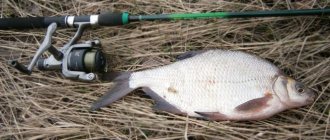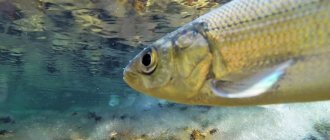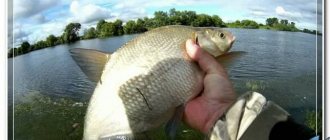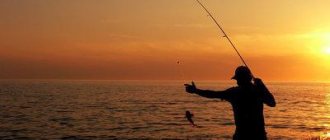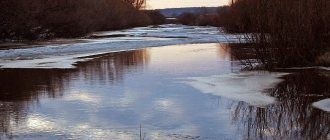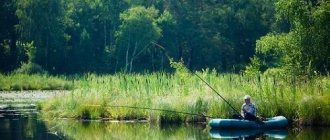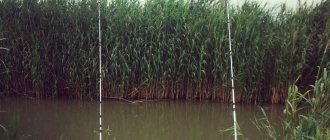Bream is one of the most voracious carp fish; its rapid growth rate, due to which it makes up the largest part of the biomass of all fish in most bodies of water, is the key to its survival. The roach, of course, is ahead of it in numbers, but due to its slow growth it is inferior to it in total mass.
The main threat to the peaceful fish of our reservoirs, pike, is not able to grab bream due to its wide body and abundance of mucus - it simply slips out of its strong teeth. The scales also protect against its mouth. However, for this to work well, the fish must quickly grow from a fry to a large individual.
Features of night fishing
Anyone who has been fishing at night at least once knows that it is very different from daytime fishing. Beginner fishermen can be given several recommendations. With them, night fishing for bream in summer and winter will be much easier.
- Stock up in advance with lighting equipment, a main and spare flashlight, reliable waterproof batteries, fuel for the fire;
- You need to have a tent in case of rain - you don’t have to worry about having a dry change of clothes in the morning;
- Try not to fish from a boat - there will be problems with orientation, especially on a large body of water, and cases of shipwrecks at night are usually more dramatic. There are quite a few videos that prove this, and it almost always means losing your boat and ruining your fishing trip.
- If you still fish from a boat, it is better to do it on a river where the outlines of the banks are familiar, clearly visible, and there are landmarks in the form of an illuminated route not far from the shore or a village with lit windows;
- In winter, you need to have a tent with heating, and also go fishing with a partner. At night, the air temperature can drop significantly, and besides, there is no sun, under which during the day in the same place you can undress and sunbathe in the rays reflected from the snow.
- In summer, bottom fishing methods and sound alarms are preferred. They will accurately and effectively show when a fish is biting, and bottom fishing requires a minimum of visual control.
- Never put anything on the ground, especially a fishing rod! There will be a big risk of stepping on the gear in the dark or not finding it later. Stock up on coasters and a table.
- Not always, but it happens that fish are afraid of light. If you are fishing with fireflies, it is better not to use them at shallow depths when casting them aground.
- Try to avoid alcohol while fishing. Even during the day, the line will constantly get tangled, the fish will run away from your hands, and night fishing will generally turn into a nightmare.
In any case, before you go night fishing for bream, you need to figure out two things:
- Is there sufficient quantity of bream in this reservoir?
- Whether or not bream bites at night or you can catch it during the day;
- Will it be possible to then fish during the morning and afternoon if night fishing is unsuccessful;
- Will there be time to sleep later?
How to choose bait for bream
Spring bait
To fish in reservoirs with a current, it is necessary to add viscosity ; for this, clay from the reservoir and pea flour are used. Fraction : small, but always with the addition of large pieces of live maggots and food bloodworms. Color : light Smell : coriander is the best option Additives to attract large fish: instant corn, crushed peas, scalded maggot
Summer baits
In the summer heat, many complain about a complete lack of bite , but this is not always true. Properly selected bait can attract the attention of bream even in the heat. June: worm, maggot, corn, peas, pasta. July: steamed barley, maggot worms in the form of sandwiches. August: bread, pasta, corn, maggot worm. Temporary decreases in temperature indicators will entail a return of bream to animal types of bait ; vegetable bait should be offered in hot weather.
Autumn lures
In the autumn, bream continue to be actively caught on the feeder; groundbait and bait, as before, should work in tandem in such gear. As the temperature drops, bream will again want “meat” baits. September: earthworm and dung worm, maggot, hominy, bread, steamed cereals. October: bloodworms, worms, less often maggots. November: maggots and bloodworms, plant-based baits will not work. It is important to understand that the bait used in crushed form must be added to the bait.
Winter lures
In winter, bait for bream is very important; it is more difficult for passive fish to attract attention . Therefore, the selection of bait should be approached very carefully. December: sandwiches made from pieces of worms, bloodworms and maggots, less often boiled peas are used. January: bloodworm, worm. February: worm, bloodworm, semolina, peas. You can experiment and try using the dough as bait; at the end of February, bream can respond well to this species.
Winter bait
This is also an element of fishing that is not so easy to guess. often the most effective. But having a sufficient supply of live bloodworms is an expensive pleasure. Therefore, fishermen usually use plant mixtures. But you also need to add at least a few larvae to them .
A bloodworm-poor mixture (fragrant porridge) is used. Bloodworms are needed only for smell, in a volume of 2-3 g per feeder.
Composition of the main bait:
- ordinary bait for catching “peaceful” fish, about 500 g;
- crushed roasted sunflower seeds;
- about 200 g of steamed millet.
If small fish do not bite very actively at night, then the proportion of bloodworms in the total mass can be increased. It will attract bream and keep it in the right place. If possible, the amount of bloodworms should be in a 1:1 ratio to the rest of the mixture.
Some fishermen use bait saturated with attractant. All fish, not just bream, can flock to this unique delicacy, generously thrown into the hole. And then the catch will be rich and varied.
But other fishing enthusiasts do not approve of this type of bait. Attractants are aromatic substances. They are expensive and their use is considered irrational.
It is better to do bait in 3 stages. First you need to lower the feeder with the main mass to the bottom. Then make small complementary foods. Then you can take a little semolina, moisten it with water and pour it into the hole.
Animal food can be hidden under a layer of plant components. In this form, the food is lowered to the bottom of the feeder. Larger individuals will easily find small red worms under a layer of crackers and other food, but small fish will not be able to cope with this.
Important. It is better to lower the feeder in the evening, several feeders at one point. It is not recommended to do this at night, because... You can scare away accumulated schools of fish.
Where to fish
Typically, summer fishing methods, such as feeder and float, require closer fishing distances at night than during the day. The fact is that the fish comes closer to the shore, can be found in abundance among thickets of sedges and water lilies, and approach the border of aquatic vegetation and especially flooded bushes. Fresh incoming flows from streams and rivulets also attract bream.
If daytime fishing for large bream usually took place in pits, then nighttime fishing can be shifted towards smaller coastal places, towards reed islands, towards the border of algae. Often a fisherman at night hears many strange sounds - smacking, rustling, splashing, gurgling, and sees moving grass stems. These are the sounds a fish makes when it approaches the shore to feed. And you can use them to find a good place. It is especially convenient to navigate this way when float fishing, because donka usually involves a longer cast.
For bottom fishing, it is better to focus on tables between two dumps. For example, there is a hole with the greatest depth, there is a coastal flat sandbank, and between them there is one large slope. If there is a table with a relatively constant depth on this slope, then night fishing in this place will bring the greatest results. The fact is that most often bites occur from 23.00 to 02.00, and then from 04.00 to 07.00. At this time, the movement of fish occurs, which tends to linger in places with a flat bottom without a slope. These are the places you should feed and throw gear there. Bream is a schooling fish, and if you fall on its “paths,” you can catch it very well.
It is impossible to give a clear recommendation on the optimal depths; it all depends on the reservoir, its flora and fauna, bottom, abundance of food and habits of bream developed in this population over many years. Somewhere the bite occurs best at a depth of half a meter, somewhere at twelve meters or more. However, at night, large bream can be found at much shallower depths than in the daytime.
Tips for choosing bait for bream
Spring baits
Depending on weather conditions in the spring, bream can actively react to different baits: March: bloodworm, worm, semolina, dough. April worm, maggot, bloodworm. May peas, corn, dough, pasta, semolina, bread, boiled wheat, pearl barley. The higher the air and water temperatures, the faster the bream switches from animal baits to plant baits.
Summer baits
In the summer heat, many complain about a complete lack of bite, but this is not always true. Properly selected bait can attract the attention of bream even in the heat. June: worm, maggot, corn, peas, pasta. July: steamed barley, maggot worms in the form of sandwiches. August: bread, pasta, corn, maggot worm. Temporary decreases in temperature indicators will entail a return of bream to animal types of bait ; vegetable bait should be offered in hot weather.
Autumn lures
In the autumn, bream continue to be actively caught on the feeder; groundbait and bait, as before, should work in tandem in such gear. As the temperature drops, bream will again want “meat” baits. September: earthworm and dung worm, maggot, hominy, bread, steamed cereals. October: bloodworms, worms, less often maggots. November: maggots and bloodworms, plant-based baits will not work. It is important to understand that the bait used in crushed form must be added to the bait .
Winter lures
In winter, bait for bream is very important; it is more difficult for passive fish to attract attention. Therefore, the selection of bait should be approached very carefully. December : sandwiches made from pieces of worms, bloodworms and maggots, less often boiled peas are used. January : bloodworm, worm. February : worm, bloodworm, semolina, peas. You can experiment and try using the dough as bait; at the end of February, bream can respond well to this species.
Search for a place
Fishing for bream in December is quite difficult and troublesome. Therefore, in addition to choosing suitable gear, it is necessary to become familiar with the favorite habitats of fish at the beginning of winter. After all, fishing in the first hole you come across is unlikely to bring success and will turn into a waste of time.
After freeze-up, bream settles at a short distance from the shore in places with contrasting topography and significant depths. Often it can be found near deep ravines or slopes, or near a flooded river bed.
Like other inhabitants of the depths, bream prefers to stay on all kinds of edges, so they should be examined first. When trying to find fish along the riverbed, it is better to make holes in a checkerboard pattern, maintaining a distance of 15 meters.
Read: Bream fishing in February
And although bream is considered an omnipresent representative of the aquatic world, it can be extremely picky about the quality of the bottom surface. He is interested in areas with a sandy or clay bottom, and is also repelled by muddy areas.
Nozzles, bait and tackle
When going night fishing, it is best to find out in advance which baits smaller bream prefer during the day. Usually the bream eats worms and crawlings with pleasure. In the daytime, small fish will interfere with its approach to the bait and will eat worms, bloodworms, and maggots. At night, you can use such baits more actively and not worry about catching small roach instead of bream. Especially in the spring, when bream take bait well on animals. It is best to find out whether it is better to catch bream with a feeder or a fishing rod during the day, and use the same baits at night.
However, night fishing does not save you from ruff, and you have to put up with it even at this time of day. Only the use of plant attachments will save you from it, and then only partially. Among vegetable baits, you should give preference to semolina porridge, mastyrka, peas, corn, pasta, and bread. There will be less chance of them being eaten by small items.
The three main types of summer fishing are bottom tackle, ring fishing and float fishing.
| With float | Only in good light or on white nights. It is quite difficult to effectively throw a float into a baited area “by touch”. |
| Fishing on a feeder | It is advisable to have casting guidelines that are clearly visible in the dark. For example, a tree visible in the moonlight or a lantern on a bridge. It is also better to prepare a pair of clipped rods for the feeding point in advance, so that if the gear breaks, you do not have to re-set it, but in complete darkness. Feeder fishing offers a lot of possibilities and flexibility, but at night this is more difficult to implement. |
| Fishing with a classic spinning rod | The casting accuracy is lower here, but the volume of bait is also larger. Less catchy gear than a feeder, but you can put several donks with bells and catch well. |
| Fishing with a donk with an elastic band | Very good for night fishing. The hooks are delivered to the same place, which can be baited; there is no need to be precise when casting - the tackle will do everything itself. The disadvantage is the short fishing distance, unless, of course, the elastic is installed from a boat, and the inability to continue fishing in a new place or if the elastic breaks. |
| Fishing with a ring, with a jar | Not a bad option, but you can fish well with a ring during the day, and night fishing from a boat will require good skill, knowledge of the bottom, and the area. Most often, it is not possible to change the place of fishing, since in the dark it can be difficult to find another hole using landmarks. It’s better to fish from the shore at night instead of the onboard method |
Bait for catching bream at night can be more abundant than during the day. Usually feeding is done in the evening, 6-8 hours before the start of bream fishing. During this time, a small bream will come up for bait and disperse the small fish a little. Subsequently, there is a high probability that larger fish will approach at night. Since feeding is carried out over a long period of time, it makes sense to carry out the starting feeding 2-3 times higher than the usual daily feeding. You can use a large amount of soil so that the food from it is eaten longer.
Features of catching large bream in December
When catching large bream there is one more feature. The bream is wide, don’t even think about making small holes. If the bream does not fit into your hole, then you can safely assume that you missed it. As long as you widen the hole and gouge it, the fish will simply come off the hook; bream does this quickly and skillfully. So take note, take a wide drill, and in order not to expose the bottom, just do not remove crumbs of ice and snow from the hole, for greater confidence you can fill it with snow, then the bottom will not be illuminated by the sun’s rays, and fishing will be less problematic.
